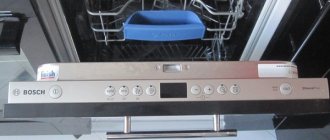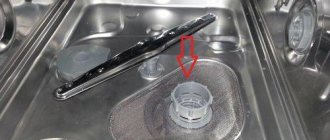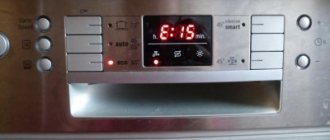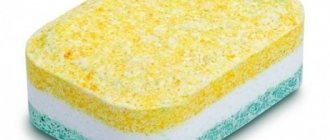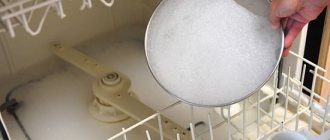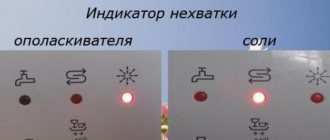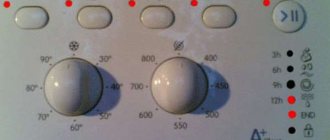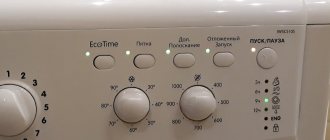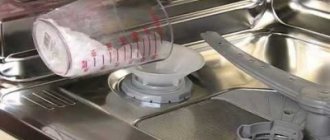The dishwasher is equipped with a control panel. Regardless of the type (electronic or mechanical), any panel is equipped with indicators and keys. These elements make it easier to select programs and allow you to understand the settings and modes. Bosch dishwasher indicators are no exception. It will be useful for you to know what the blinking of a particular light bulb means.
What do the indicator signals mean in the Bosch PMM?
The control panel for the dishwasher can be located on the front panel or on the top. The latter is most often installed in built-in dishwashers. Running modes indicate that they are turned on by the indicators lighting up. In the same way, malfunctions in the operation of equipment can occur.
The meaning of the meaning is sometimes indicated by the manufacturer in the instructions. But the descriptions are not always clear to the user. Take a look at the picture below. All light bulbs are marked with different patterns. What do they mean? Let's figure it out now.
- Light bulb number 1 is indicated by a brush. This means that the dishwashing mode has started.
- 2 (END) — end of the cycle.
- 3 (tap) is on—water is being poured into the hopper.
- 4 (two arrows) - presence of salt in the compartment. The product must be constantly added to the PMM. Salt prevents the formation of scale and white deposits on dishes.
- 5 (sun, snowflake) - message about a lack of rinse aid in the hole. For high-quality washing and shiny dishes, use high-quality rinse aid.
If the lights are not lit, then the option is not activated. Also, the diodes can flash when one of the functions is activated, informing the user about the choice made.
- 1 (+) — the temperature is selected in the range of +65–75 degrees.
- Icon number 2 (AUTO) on the panel indicates the start of the automatic program.
- 3 (-) - set temperature from 35 to 45 degrees.
- 4 (Eco) - economical washing mode at 50 °C.
- 5 (glass and cup) - fast cycle at 45 °C.
- 6 (shower) - dishes are rinsed in advance.
Hansa dishwasher indicators - E1/E4
- E1/soaking/faucet icon flashes - indicates problems: lack of sufficient pressure, the water tap to the device is closed, or the water in the house is turned off. In the absence of the listed problems, it indicates maintenance problems - a call to the technician is required.
- E4/ECO warning light - incoming water level too high/overflow, may also require calling a repair technician.
Why are the lights blinking?
Flashing indicators may indicate a problem with the dishwasher. This is often how the diagnostic system works in cars without a display. By deciphering the meaning of the code, you can quickly find the location of the breakdown.
If you encounter an issue where the unit won't fill with water, don't panic. At the same time, the “Crane” and “END” diodes blink simultaneously on the panel. You can hear the valve humming, but for some reason there is no water. Here are the main reasons:
- Low pressure in the main.
- The inlet valve is closed.
- The inlet hose or strainer is clogged.
- The Aquastop leak protection has activated.
It also happens that the water and detergent supply LED flashes at the same time. After checking, it turns out that water is entering the chamber, and you just poured the product into the compartment. What is the reason? Check the circulation pump. This unit supplies liquid under pressure to the nozzles. For an accurate diagnosis, it is better to consult a specialist.
This is how you can determine what the display on your dishwasher means. In some cases, you cannot do without the help of a specialist.
As soon as the connection work is completed, the user understands how to start the equipment. To do this, you need to understand what the icons and indicators on the dishwasher panel mean. If you don’t have the instructions at hand or you don’t understand the manufacturer’s instructions, our article will help.
Selection rules
This miracle of technology first appeared at the end of the 19th century, and since then more and more housewives have purchased this machine for their kitchens. Before purchasing, you should study the safety rules for operating the device.
Initially, you need to check the unit for damage inside and outside. They may occur due to improper transportation. If you notice dents and chips, do not accept the equipment and do not sign delivery certificates, otherwise nothing can be proven later.
You should not install the dishwasher yourself. It’s better to turn to specialists and rest assured that the device will work without interruptions. The instructions for devices from Bosch, Ariston and Electrolux describe in detail how to make the connection. Therefore, if the installation will be done by yourself, you should first read everything thoroughly.
The machine is installed horizontally and secured well so that it is stable. It is prohibited to install devices in rooms with zero or lower temperatures.
Identification of signs on the dishwasher
The location of the panel depends on the type of dishwasher. If this is a built-in model, the keys and indicators are located at the end of the door. Since the front part of built-in PMMs is hinged, there is no need to place the control system on the front part of the door.
Freestanding machines are a full-fledged element of the interior, so the control panel is located on the front part. Buttons and indicators may be labeled, but often these are foreign names that cannot be understood without instructions. It is more convenient when the keys are designated by symbols: pan, snowflake, asterisk. Then the user can intuitively understand the meaning of the buttons.
The variety of symbols depends on the brand of the car (Ikea, Ariston, Siemens). And also on the number of functions of the model.
Let's look at the designations of the most popular brands of dishwashers.
Distinctive features
When you decide to purchase a Hans dishwasher, you should learn about the features and advantages of the equipment.
These include:
- Stylish, modern design of each model . Any Hans device can fit harmoniously into the kitchen interior;
- saving . Thanks to the Hansa dishwasher you can significantly reduce electricity, water and your time, which you can devote to more important matters;
- effective cleaning . The machine can easily cope with any degree of contamination, perfectly washing each product.
Identification of signs on the dishwasher
The location of the panel depends on the type of dishwasher. If this is a built-in model, the keys and indicators are located at the end of the door. Since the front part of built-in PMMs is hinged, there is no need to place the control system on the front part of the door.
Freestanding machines are a full-fledged element of the interior, so the control panel is located on the front part. Buttons and indicators may be labeled, but often these are foreign names that cannot be understood without instructions. It is more convenient when the keys are designated by symbols: pan, snowflake, asterisk. Then the user can intuitively understand the meaning of the buttons.
The variety of symbols depends on the brand of the car (Ikea, Ariston, Siemens). And also on the number of functions of the model.
Let's look at the designations of the most popular brands of dishwashers.
Bosch (Bosch)
Bosch dishwashers are the most popular on the Russian market. Manufacturers have created a wide range of models, a wide variety of modes and are introducing new technologies. Let's look at the decoding of the most common symbols (follow the numbering in the picture).
- Pan with stand (1). The symbol speaks for itself - intensive mode (70 degrees), which allows you to wash heavy dirt from pots, baking sheets, and frying pans. Duration - 115 minutes, water consumption - 21 liters.
- Auto (cup and saucers) (2). “Automatic” mode (one might say “Standard”) takes place at a temperature of 45-65 degrees. Suitable for a variety of dishes, except for items made of delicate materials. Operating time - 140 minutes, consumes 19 liters.
- ECO (Economical Cleaning) or glass and cup on a plate (3). Initially, a “Pre-rinse” is carried out, and then a program at 50°C. Lasts 140 minutes, spends 14 liters.
- A glass with a cup on a stand and two arrows to the right (4) - a quick cycle without an initial rinse at 45 degrees. Characteristics: 30 minutes, 10 l.
- “Shower” of water drops (5) – “Pre-rinse”. The program allows you to clean dishes from food residues and prepare appliances for a thorough wash. Time: 19 minutes, water: 4 l.
- One glass. Indicates “Delicate wash”, works at a temperature of 40 degrees. In this case, you can wash fragile items. Takes 75 minutes, spends 15 liters.
- Plus and minus with the letter h (6) - allow you to adjust the cycle time.
- Clock with arrows to the right (7) - reducing the duration of the mode by half (VarioSpeed).
- ½ (8) - half load mode. If you haven't collected dirty dishes for a full cycle, load only half with a 30% resource saving.
- Pan with rocker arms (9) - “Intensive Zone”. Water flows into the lower part under stronger pressure than into the upper part.
- Baby bottle (10) - the hygienic mode allows you to process dishes at high temperatures. Perfectly disinfects children's dishes.
Selecting a program
You can wash dishes using various programs. Their symbols on the dishwasher panel are located next to each other.
The instructions usually describe a set of possible functions that must be studied before you start using the unit.
The dishes are washed well when washed with the standard program (the symbol on the dishwasher is economy or eco). If the dishes are very dirty, you should use the intensive program. Then the dishes are washed well, but the consumption of water and electricity also increases.
The delicate mode washes wine glasses, glasses and glassware. To do this, a special thermometer is installed in the machine, which heats the water to the desired temperature during the first rinse.
The machine washes the dishes in about an hour. At the end, all the dishes will be hot, so it is recommended to wait 15-20 minutes before removing them from the machine. To avoid drips, remove the bottom rows first, and then the top ones.
Legend
Let's now decipher the designation of the icons on the dishwasher:
- On – the machine is running when the indicator lights up;
- Off – Finishing washing, the machine turns off;
- Pre-wash – quick rinse with warm or cold water. Necessary to soften dried small food residues on dishes;
- Intensive - several washes in hot water, then a standard wash and several rinses in cold water. Then the dishes are rinsed with a special product and dried. This program should be used for heavy soiling and for washing greasy pots and pans;
- Normal - quick and basic washing, rinsing and rinsing, finally drying;
- Gentle - quick and basic washing, rinsing, and instead of drying, ventilation is used so that at very high temperatures the glass does not crack;
- Quick - basic wash, several rinses and ventilation;
- Bioprogram – washing with special detergents with enzymes is carried out;
- AUTO – the program itself calculates how to wash dishes using water. The dirtier the water, the more intense the washing will be;
- Economical - washes dishes with not very hot water and does not take as long as other programs. For this mode, you need to put all the dishes in one container;
- Drying only – necessary for drying dishes;
- Warming plates – you can warm plates and put food on them so that the food does not cool down quickly;
- Rinse aid level – lights up when the rinse aid runs out;
- Salt level – lights up when there is insufficient amount of regenerating salt in the device;
- The middle sprayer is blocked - indicates that the dishes in the bottom row are not distributed correctly;
- Clean the filter system – lights up when the filters are dirty;
- Open the tap - the indicator lights up when no water flows into the machine.
As you can see, all the symbols on the dishwasher Bosch, Ariston and others are clear and not as scary as they initially seem. Each housewife knows her technique and, over the years of use, learns all the signs by heart.
Knowing what the marking of Bosch washing machines means will help you with your own repairs and in finding the necessary parts. The encoding will let you understand what kind of equipment is in front of you and what its main parameters are.
To date, several series are entering the market (until the beginning of 2016):
We will help you decipher the coding of Bosch washing machines from the lines listed above and more.
Before deciphering what this or that designation means, you need to find the location of the encoding itself. You will find the alphanumeric combination on the service sticker or in the technical documentation for the washing machine.
Let's look at how decoding occurs using the example of one of the models. Let's take WLK24271OE W as the original serial number.
The meaning of the first letter tells you what type of equipment is in front of you. In this case W
- This is a washing machine.
The second letter indicates the type of SMA. English letter L
indicates that this is a narrow washing machine with a front-loading type of laundry into a drum with a depth of 45 cm. Other letter variations:
- I
– Built-in front model. - A
– Front-type machine with a standard depth of 60 cm. - O
– Vertical type washing machine. - V
– Dryer. - K
– Integrated washer-dryer. - E
– Fully built-in washing machine, equipped with a hinged door.
The decoding of the third letter indicates the series:
In later models, it denotes the class of the machine, and you can find the following letters:
- S
– F Premium with a load of 8 kg. - E
– FV, medium. - A
– FX, basic. - X
– SV, 40 centimeters, medium. - V
– P20. - T
– PV, medium with vertical loading type. - R
– PX, basic, vertical loading of laundry. - D
–W.V. - C
–WX.
- 12
– 600, - 16
– 800, - 20
– 1000, - 28
– 1400, - 32
– 1600, - 36
– 1800, - 40
– 2000 rpm.
On a note! If you forget what the spin code means, divide the number of revolutions by 100 and multiply by 2.
Another digital combination is the designation of the control type (digital display and so on).
The last letters in this washing machine code indicate where they are made. This information is of particular interest to users seeking to buy an imported machine.
The Bosch concern manufactures SMA in different countries, which correspond to the letters:
- OE
– Russian Federation, Belarus, Ukraine. - EE
- Spain. - GB
– Great Britain. - EU
– Europe (Eastern and Western). - BY
– Eastern Europe.
Now you can easily decipher any marking on the Bosch SMA. Save the decryption scheme, you may need it later.
Have you decided to buy kitchen appliances? We'll tell you how to do it correctly. The marking of a dishwasher is a hidden designation of the capabilities and functions of the equipment. To choose the best PMM, learn to decipher these symbols, then you won’t need any instructions.
In the article we will analyze in detail each letter in the Siemens and Bosch codes.
PMMs of these brands are the most popular on the Russian market today. Since both lines are produced by the same concern, the meaning of the markings for these companies is similar. Therefore, we have combined the designations for the Bosch and Siemens brands.
Let's look at the decoding of the Bosch SPS40E12RU model. The first word always means the brand of the product, for example “Bosch” or “Siemens”. Next comes the first letter S - it always means the type of equipment. The manufacturer indicates that this is not a washing machine, but a dishwasher.
The following symbol indicates the type of dishwasher, as well as the production time:
- P is a narrow device, body width up to 45 cm. These are built-in models of the latest generation (the most modern).
- R is also a narrow PMM, but of the first generation.
- G - free-standing devices 60 cm wide, previous generation. Considered standard.
- M - conventional PMM with dimensions of 60 cm - second generation.
- B is the latest model with a non-standard case height of 85 cm.
- K is a type of non-standard machines that are suitable for desktop installation.
The third symbol in the dishwasher article number will indicate the type of installation:
- S (Solo) is a free-standing appliance that is placed in the kitchen without being built-in.
- I (Integriert) - partially built-in PMM. Its panel remains open and is not completely hidden behind the headset.
- V (Vollintegriert) - completely built into a cabinet or niche in the kitchen. Often has special fastenings for hanging the facade door.
- U (Unterbau) - the machine is completely installed in furniture and has its own metal facade.
Main programs
When studying the technical characteristics of a Bosch or Siemens dishwasher, the user pays attention to the number of functions. The standard set of programs includes from 4 to 6 main modes. You can recognize this by the following designation, where the number 4, 5, 6 or 8 is indicated: SPS40E12RU.
PMM equipment
The presence of additional technologies is indicated by the following symbol: SPS40E12RU. For example, the number 8 will tell the user that the design includes a VarioDrawer basket, which can move up and down and be adjusted in size. Number 9 - the same technology is present, only the sound insulation is better.
Categories
- E - lower or “junior” class. Accordingly, the cost of equipment is minimal.
- N—beginner or above intermediate.
- M - middle class.
- T - upper or highest price category.
- U - elite, premium class.
Do not confuse price classes with designations of consumed resources. Typically, such markings are glued to the body of the machine, which indicates how much PMM consumes energy, consumes water and produces noise.
The penultimate two digits do not provide information to the user. Therefore, let us dwell in more detail on the last two notations.
Place of production
Where is the equipment made? This question worries many buyers. Now you have the opportunity to find out the truth from the manufacturer, and not from a consultant in the store.
The last two Latin letters indicate where the car will be sold. For example, the designation RU means that dishwashers were produced for Russian consumers, and EU for European consumers.
Additionally, on the packaging or panel of the equipment you can see markings that indicate the place of production:
- SAS, SLX, SLF - made in Germany.
- SAE, SOR, SFX - made in Poland.
- SFO - originally from Turkey.
- SLM - made in China.
- SOT - Made in France.
Important! The decoding is relevant for models released after 2006.
Information for preliminary review. The official information of the manufacturer is not.
for working with a dishwasher
Always refill when the rinse aid low indicator is illuminated!
The dishes sparkle clean.
Load detergent
Less dirty dishes require less detergent.
and close the lid.
Adjusting the water softener *
Find out the water hardness
at the organization that supplies you with water, and
write it down below
.
Define the value to be set.
*
just
before
use
or when
water hardness changes
Load regeneration salt
into the hole for
salt
(not detergent
Dissolves lime (not required if water softener is set to «0»!
) .
All dishes are clean. When the beep sounds, open the door. The program end indicator lights up. Turn off the main switch.
Fast, economical or intensive washing.
Brief overview of programs
Electricity consumption, kWh
This brief overview shows the maximum possible number of programs. Please look at your machine's control panel to see what programs are available on your machine.
Values obtained from laboratory measurements in accordance with European standard EN 50242. Deviations may occur in practice.
The dishwashing begins. Press the main switch, select a program, close the door.
short and convenient: everything you need
for your dishwasher.
Before using the dishwasher, please
What preventative measures should be taken?
Prevention methods:
the use of high-quality dishwashing detergents that do not contain chemicals that damage the internal structure of the PMM;- use of special steel to prevent corrosion;
- Before installing the dishes, all food residues are carefully removed;
- It is not recommended to install dishes with strong burning (they are pre-soaked to remove particles);
- Periodically clean the filter with water and soapy water to prevent excessive contamination.
These methods will help you use your dishwasher for many years without any problems.
Why are dishes labeled?
The markings on the cookware indicate how functional the cookware is. Remember your grandmothers. As a rule, they had few dishes. One or two cast iron frying pans, clay pots, and everything was cooked in one oven.
Modern kitchens are equipped with ovens, stoves, and microwave ovens. Each model has its own temperature regime and cooking method. The cookware is also different - grill, non-stick, with induction support. All this requires a lot of attention when choosing. After all, ignorance can cause harm to yourself and the equipment.
This is due to the fact that the damaged surface will release substances that can harm health.
And for induction cookers, pots and pans are suitable that have a special alloy of material that forms a magnetic layer. Due to this magnetic layer, food is cooked.
When choosing dishes, the icons depicted on the surface can be misleading. To avoid troubles when cooking, you need to know what the icon means.
Thus, the marking of the cookware can tell you which stove the cookware is suitable for. After all, there are now so many types of cookers – glass ceramics, induction cookers, electric and gas. And there are ten times more materials for dishes.
Labeling is a guarantee of safety. If you choose low-quality cookware or use it for other purposes, you can get unpleasant consequences, for example, health problems. Also, an incorrectly selected pot or frying pan can cause irreparable damage to the stove and oven. Repairing equipment will not be easy, and it will also be financially expensive.
Description of controls
In everyday use, a Bosch dishwasher is unlikely to cause much difficulty in use. Many lights and modes remain unused. But to use a Bosch dishwasher comfortably, you need to know what each of the signal indicators means. Let us first consider those that are present on almost all models and indicate various stages of work.
- “End” indicator – indicates the end of the dishwashing cycle.
- “Brush” indicator – lights up when the dishwasher starts.
- “Tap” indicator – signals the period of operation when the cavity of the machine is filled with hot water.
- The “Salt” indicator (two arrows in the shape of the English letter S) - indicates the presence of a salt absorbent, which helps clean the heating element from scale that has formed on it.
- The “Rinse aid” indicator (snowflake, sun, star) indicates the presence of dishwashing liquid in a special compartment.
The keys responsible for setting and regulating the upcoming wash are allocated to a separate category. The functionality of each Bosch model is very different, so only those buttons that are most common will be described.
- “Pan” - this symbol indicates an intensive mode of washing dishes at a temperature of more than 70 degrees Celsius and lasting about an hour. Used for the heaviest stains.
- “Cup and saucers” (or Auto mode) is the standard operating mode. Similar to when we wash dishes by hand. Water temperature - 50 degrees. Duration – up to two hours.
- “Cup and plates” (ECO, economy) – mode of reduced water consumption. It differs from the standard one in the presence of a rinsing stage.
- “Glass (cup) with two arrows” – accelerated washing. It passes in half an hour at a temperature of about 40 degrees Celsius.
- “Glass” – delicate mode. Used for fragile dishes.
- “Baby food bottle” – treatment of dishes with hot water, which destroys germs. Used to disinfect baby supplies (dishes, pacifiers, etc.).
Asko
The icons on standard Asko brand dishwashers are also extremely simple and easy to understand. After the first use of the device, you can easily understand its functions, and their number depends on the model of a particular machine and its cost. Most often on the panel of such machines you can find the following icons and pictograms:
- star – the ability to add a frequently used program to the favorites list;
- Delay – delayed start option;
- tablet – the ability to use dishwashing detergent in the form of tablets;
- pan (or plate) – standard washing mode;
- lock - the ability to lock the machine door to protect it from children.
Types of errors on devices with a digital display
Most modern Bosch dishwashers are equipped with such digital panels. Error indicators will light up on them if the dishwashing process failed to start. This facilitates the diagnostic process, and therefore the speed of repair. It is highly not recommended to repair such complex equipment yourself. Contact the appropriate service center. We remind you, do not forget to put your Bosch dishwasher into service mode.
- Uniform flashing of all indicators – software failure;
- E01 – control unit failure;
- E1, F1 – sensor malfunctions;
- E02 – wiring break;
- E2, F2 – heating errors;
- E03 – drying does not occur;
- E3, F3 – tank is not filled;
- E04 – see E02;
- E4, F4 – malfunction of the spray mechanism;
- E05 – see E01;
- E5, F5 – leakage or overflow of the tank;
- E06 – the chamber is not sealed (problems with the locking mechanism);
- E6, F6 – failure of the incoming water quality sensor;
- E07 – fan failure;
- E7, F7 – drain pipe clogged;
- E8, F8, E08 – low water level;
- E9, F9, E09 – problems with power supply to the heating system;
- E10, F10 – see E03, E07;
- E11, F11 – no data from the temperature sensor;
- E12, F12 – contamination of the heating element with limescale;
- E13, F13 – incoming water temperature is too high;
- E14, F14 – error in the water distribution system;
- E15, F15 – tank leak;
- E16, F16 – valve leakage;
- E17, F17 – the incoming water pressure is too powerful;
- E18, F18 – see E3, E14;
- E19, F19 – malfunction in the system;
- E20, F20 – problems with the pump;
- E21, F21 – see E3, E20;
- E22, F22 – drain system clogged;
- E23, F23 – breakdown of the pump responsible for removing water from the tank;
- E24, F24, E25, F25 – see E22;
- E26, F26 – flow sensor failure;
- E27, F27 – problems with the electrical network;
- E28, F28 – see E6;
- E29, E30, F29, F30 – see E27.
Modern models of dishwashers are equipped with various indicators that facilitate operation and make it clear and simple. Indicators in the form of LED bulbs are not only a source of information about the dishwashing process, but also possible malfunctions. In this article we decided to talk about the indicators of Bosch brand dishwashers.
Types of faults
Most problems that can occur with a Bosch dishwasher do not lead to its complete failure. Modern equipment is equipped with sensors that prevent them from starting if any part is in poor condition. The user will be notified of this either by flashing indicators or an error code on the display of the Bosch dishwasher.
Moreover, the exact startup error can only be determined by putting your dishwasher into service mode. To do this, you need to hold down a combination of some indicators on the panel, which is described in the instructions. Those signals that can be seen in normal mode give only an approximate indication of the problem.
Water does not heat up to the required temperature
Defects associated with the water heating function occur in the operation of Bosch PMMs less frequently than previous breakdowns. All of them are associated with incorrect operation of the electric heater.
| Code | Description |
| E01 | There is a break in the heating element circuit or a violation of its contacts. The reason is that the electric heater burned out. In addition, the following are possible: a break in the cable connections of the circuit, a malfunction of the triac on the ECU board that controls the operation of the heating element |
| E2 | The temperature sensor (hereinafter also referred to as the thermistor) has failed or its connection with the control unit has been broken. The error may appear simultaneously with E01 |
| E09 | This error appears only in those Bosch PMM models that have a flow-through heating element built into the pump. The reason is damage to the heater or a violation of the integrity of its circuit |
| E11 | The thermistor turns off due to several reasons: open circuit, lack of supply voltage, or poor contact in the connector or on the ECU board |
| E12 | Too much scale has formed on the surface of the heating element. Often, after rebooting the dishwasher (in order to reset this error), failure code E09 appears |
Indication of a malfunction of the electric heater built into the pump
To determine the integrity of the heater and electronic circuits, use a proven method - diagnose them with a multimeter. A working heating element has a resistance of about several tens of ohms. The resistance at the temperature sensor contacts should be within 50 kOhm. If during testing the device shows a break or short circuit, the part must be replaced with a serviceable one.
If E12 is defective, you can get rid of scale on the heater by washing it with a solution of vinegar or citric acid.
